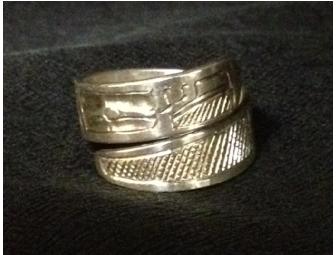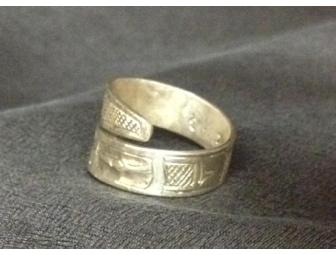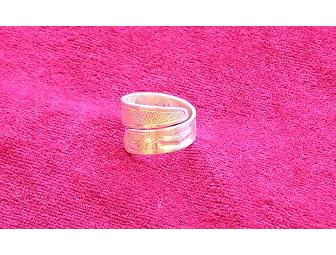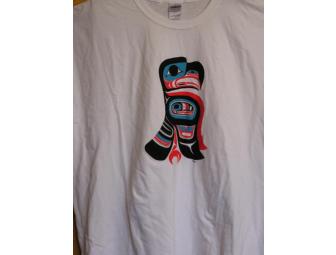Jewelry
Silver Eagle Wrap Ring and T-Shirt with Original Design by Terrence R. Campbell
- Item Number
- 317
- Estimated Value
- 150 USD
- Sold
- 151 USD to Wdarwin
- Number of Bids
- 11 - Bid History
Item Description
Pacific Northwest style etchings around the exterior of the ring in the form of an eagle, the interior is signed by the artist. Size is adjustable. Tufa cast.
The T-Shirt features Campbell's orginal design from his clothing line. Sz XXL and made of 100% Heavy Cotton
Terrence R. Campbell is a Tahltan carver from Telegraph Creek, BC, Canada. He studied the art of wood carving under master carvers Dempsey Bob and Dale Campbell, and then transfered this craft into jewelry. He is an accomplished jeweler with a distinct and clean style of engraving. His jewelry is featured in galleries across North America and is regularly displayed at the SWAIA: Santa Fe Indian Market .
His Tahltan name is "Eth-Cath-Kee" which means "Boy of the Morning Dawn, Teacher of the Children". He was given the name by his great grandmother who was a traditional herbal healer. Another great grandfather was the last medicine man in the tribe and and Terrence carries the
se bloodlines and includes healing in his current work.
About tufa casting:
The process of casting silver into tufa stone developed among the Navajos in the late 1800's. In the early years, Navajos were taught how to work silver from the Spanish. The art-form in the early years were very crude and dirty; even with modern technology, the art remains essentially the same with the exception of melting the silver.
In the 1800's the use of torches and gasoline was non-existent. In order for a silversmith to melt silver, he would have to build a fire and let in burn overnight. The charcoals’ embers were then collected in a tin bucket, to condense the area of heat. Silver coins were then placed in a pottery shard that was fashioned into a crucible. The crucible was then placed in the tin bucket to melt it. The silversmith then would bellow the flames for about an hour, and then the silver would become molten. Today, the modern silversmith use torches to melt the silver.
Other than melting the silver, tufa casting has essentially remained the same: Tufa stone casting is where a stone (tufa) is carved and molten metal is poured into the carved design. Basically, the idea to tufa cast silver is to 1. carve the design into the tufa rock 2. melt silver 3. pour the molten silver into the tufa rock mold.
Tufa stone is a volcanic, porous stone that is found naturally in the area of the Navajo Reservation. The stone is very soft and can be scratch with a piece of metal. Although the stone is never heated, it works great at these high temperatures.
Tufa casting is a delicate art. Molds typically only last one, or two casting. Then they are no longer usable. The texture of the tufa stone leaves its distinctive texture on the finished piece, resulting in a sandstone-like texture. As the piece is finished, it is often refined with filing and polishing, further shaping, as well as stone or inlay embellishments. Tufa cast pieces are one-of-a-kind works of art that can never be replicated.
Item Special Note
After the auction closes, items will be shipped to the winning bidder and actual shipping charges (including insurance) will be added to the total bid, unless bidder chooses pickup options listed in your winning bid confirmation at the close of the auction.
Donated By:
Terrence R. Campbell
KUNM stores data...
Your support matters, so KUNM would like to use your information to keep in touch about things that may matter to you. If you choose to hear from KUNM, we may contact you in the future about our ongoing efforts.
Your privacy is important to us, so KUNM will keep your personal data secure and KUNM will not use it for marketing communications which you have not agreed to receive. At any time, you may withdraw consent by emailing Privacy@frontstream.com or by contacting our Privacy Officer. Please see our Privacy Policy found here PrivacyPolicy.




